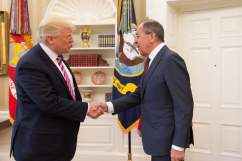
Donald Trump with Russia’s Foreign Minister Sergei Lavrov. (Official White House Photo by Shealah Craighead)
Less than 12 hours after National Security Adviser H.R. McMaster said the Washington Post’s bombshell report that President Donald Trump shared highly classified information with Russia‘s Foreign Minister Sergei Lavrov and Ambassador Sergey Kislyak during a closed Oval Office meeting on May 10, Trump himself confirmed that he did share information with the Russians about an Islamic State threat. He noted that it was completely legal for him to do as President, but didn’t say if the information was classified or not.
“As President I wanted to share with Russia (at an openly scheduled W.H. meeting) which I have the absolute right to do, facts pertaining to terrorism and airline flight safety. Humanitarian reasons, plus I want Russia to greatly step up their fight against ISIS & terrorism,” Trump wrote. Notably, the messages didn’t decry the Post as “fake news.”
Trump then tweeted that he has been asking “Director Comey & others” since the start of the administration to find “the LEAKERS in the intelligence community.” Trump has yet to finish this thought, but it’s notable that the Post wrote that it would not share the same details Trump did “at the urging of officials who warned that revealing them would jeopardize important intelligence capabilities.”
On Monday, The Washington Post reported that Trump shared highly classified information with the two Russian diplomats during the meeting, which no U.S. press outlet was allowed to cover. The information came from a U.S. ally, who did not give U.S. intelligence agencies clearance to share it. Officials told the Post that the information was considered so sensitive that it was even restricted within the U.S. government.
Although Trump did not reveal who the partner was, officials told the Post that he told Russia the city within ISIS-controlled territory where the partner found the threat. He also revealed details of how ISIS was perusing the plot, which later led the U.S. to banning electronic devices from flights entering the country from eight Islamic-majority countries.
In the hours after the Post story was published, the Trump Administration quickly denied it.
“During President Trump’s meeting with Foreign Minister Lavrov a broad range of subjects were discussed among which were common efforts and threats regarding counter-terrorism,” Secretary of State Rex Tillerson said in a statement. “During that exchange the nature of specific threats were discussed, but they did not discuss sources, methods or military operations.”
“This story is false. The president only discussed the common threats that both countries faced,” Deputy National Security Adviser Dina Powell said.
Then, McMaster delivered a brief statement to the media, telling reporters that the “story that came out tonight as reported is false.”
“The president and the foreign minister reviewed a range of common threats to our two countries, including threats to civil aviation,” McMaster said. “At no time, at no time, were intelligence sources or methods discussed. And the president did not disclose any military operations that were not already publicly known.”
However, the Post specifically reported that the President didn’t discuss the “sources or methods” of how the intelligence was gathered. The Post reported that Trump revealed the information itself. The Post also noted that Russia could use the information, especially the name of the ISIS-controlled city involved in the plot, to figure out which U.S. ally was the source of the information and how it was found.
“This is code-word information,” a U.S. official told the Post. Trump “revealed more information to the Russian ambassador than we have shared with our own allies.”
In its own report on Trump’s meeting, The New York Times reported that the ally has specifically told American officials that it would stop providing information if it was shared too widely.
Trump’s own statement appears to contradict what McMaster said. It also comes just days after Trump tweeted on May 12 that we can’t expect “perfect accuracy” from his surrogates because he is a “very active President.”
The situation also mirrors last week’s firing of FBI Director James Comey. While members of his administration – including Vice President Mike Pence – said Comey was fired over his handling of the Hillary Clinton email investigation, but Trump later told NBC News that he fired Comey because of the “Russia thing.” Trump also said he was planning on firing Comey for months, even though others in his administration said he didn’t make the decision until after he received a memo from the Justice Department.
The meeting with Kislyak and Lavrov took place just a day after Trump fired Comey, who was leading an investigation into alleged ties between the Trump campaign and Russia during the 2016 presidential election.
